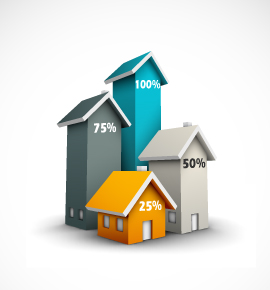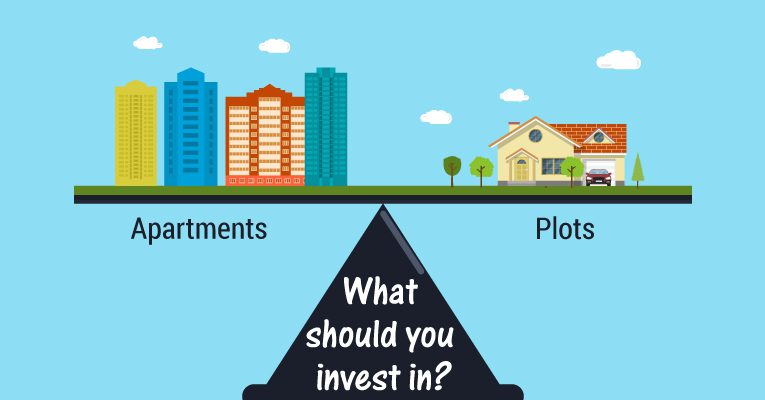In modern India, the convergence of major dynamics—a surging economy, a rising middle class, rapid urbanization, and limited land—is creating outstanding opportunities for real estate investors. White-collar jobs are being created at an unprecedented pace, and simply put, all these urban professionals need places to live, both now and in the years to come.
New apartments are one of the most popular buys in this hot market, as are parcels of land in plotted developments (gated communities of home sites). And with good reason—both can offer solid returns, especially when purchased from a reputable developer and at an early stage. So if you, as an investor, have narrowed down your choices to a plot or a flat, which one is better?
The answer depends on your particular needs. Described below, with a view to helping you select the type that is right for you, are some of the differences between these two types of real estate investment.
1. Appreciation
When investing in property, you will naturally expect to see the value of your asset increase over time. The degree of appreciation will depend on two primary factors: a) the underlying value of the land, and b) the going rate of construction costs. The latter is generally determined by the level of inflation of raw materials. India’s relatively high inflation rate is therefore pushing apartment prices upward, year upon year. That being said, raw land and plots appreciate at an even faster pace. The main reason is that as the population swells in cities across India, land is becoming increasingly scarce—and therefore, more sought after.
2. Investment duration
 Your desired holding period may also influence whether a flat or a plot suits you better. Before investing, you will need to consider how long you are willing to wait for a new property to be completed. In the case of plots in a gated community, timelines for the construction of roads, infrastructure, landscaping, and amenities are comparatively short. New apartment complexes, by contrast, can take longer to finish because of the extent of construction required. An investor can usually exit his or her investment in a plotted development within one or two years; for an apartment, the wait may extend to three years or more.
Your desired holding period may also influence whether a flat or a plot suits you better. Before investing, you will need to consider how long you are willing to wait for a new property to be completed. In the case of plots in a gated community, timelines for the construction of roads, infrastructure, landscaping, and amenities are comparatively short. New apartment complexes, by contrast, can take longer to finish because of the extent of construction required. An investor can usually exit his or her investment in a plotted development within one or two years; for an apartment, the wait may extend to three years or more.
3. Cash flow
One of the points for you to think through when deciding between an apartment and a plot is cash flow. Leasing out a flat can turn it into an income-producing asset. In India, an apartment typically fetches 3-4% of its value in annual rent. While this is lower than average rental percentages in other countries, it still represents welcome cash flow for many owners. Since plots cannot be rented out, they offer no opportunity for such income; in fact, an investor should expect a negative cash flow for a plot once ongoing maintenance costs and related fees are figured in.
4. Flexibility of investment value
 Plots have the advantage of offering lower entry prices simply because they do not carry the expense of construction. If the plot is in a prime area, the ticket price of the land may still reach crores, but in an emerging location a plot may cost as little as a few lakhs. Flats, too, come in a range of prices in India, but within a narrower band. A new option for flexible investing, whether in a plot or an apartment, is to purchase through an aggregating service which enables you to invest with flexible down payment options to suit your budget.
Plots have the advantage of offering lower entry prices simply because they do not carry the expense of construction. If the plot is in a prime area, the ticket price of the land may still reach crores, but in an emerging location a plot may cost as little as a few lakhs. Flats, too, come in a range of prices in India, but within a narrower band. A new option for flexible investing, whether in a plot or an apartment, is to purchase through an aggregating service which enables you to invest with flexible down payment options to suit your budget.
5. Due diligence
Regardless of the type of property, it is important to ascertain that the legal right to the land is in order before you buy. With apartments this is simpler; indeed, gauging the financial stability of the developer is the most important matter to investigate. With plotted developments, more careful examination is required. Developers often look to the untouched outskirts of a city when searching for large tracts of land upon which to build a gated community; in these locations, disputes about the land rights may arise because of title issues or inheritance laws. Therefore, when investing in land in India, you should either budget the resources necessary to examine documents meticulously or purchase the land through a property service which engages top law firms to undertake due diligence on your behalf.
6. Liquidity
Lastly, plots and flats differ in terms of liquidity. You will need to anticipate how much time you would be willing to wait for an appropriate buyer once you decide to put your property on the market. While a range of factors will influence how quickly any particular piece of real estate can be sold, plots are easier to liquidate because they have lower ticket sizes. Across the board, plots have a higher sales velocity than flats.
In summary, plots in gated communities and new apartments represent two of the most exciting real estate options in India today. This is particularly true if you make these purchases at an early stage in the construction cycle and from a reputable developer. If you are deciding between these two types of real estate as your next investment, bear in mind the differences between them and choose the one that best fits your individual needs.
